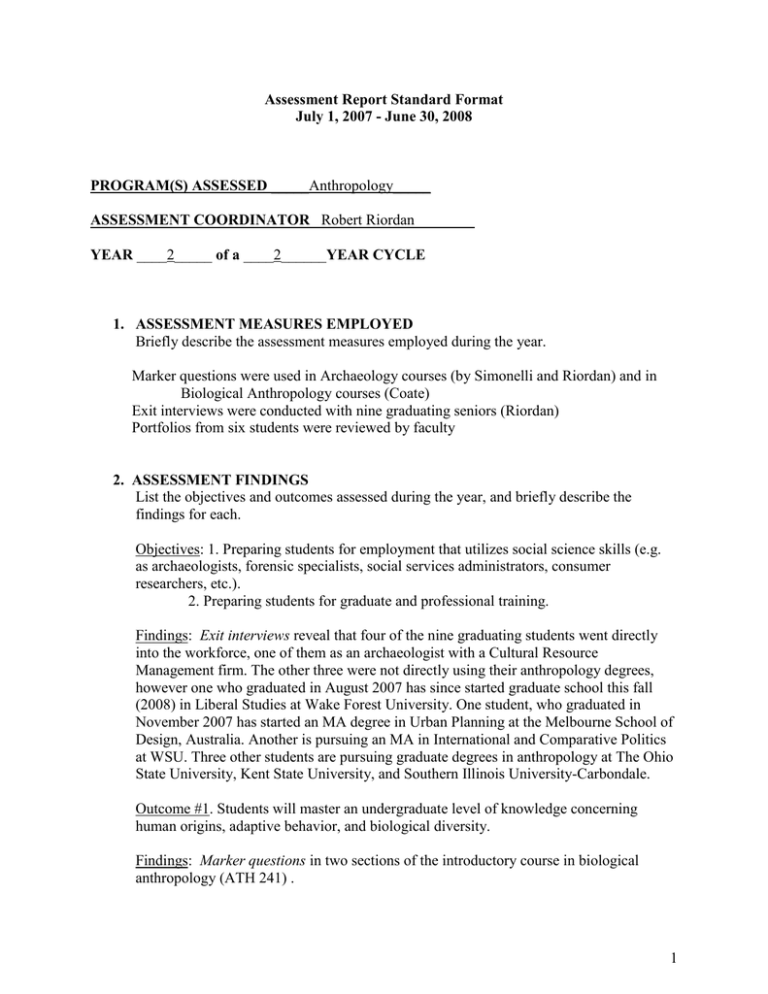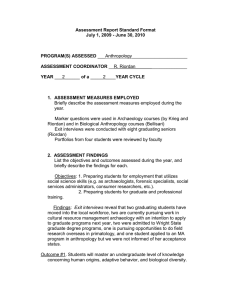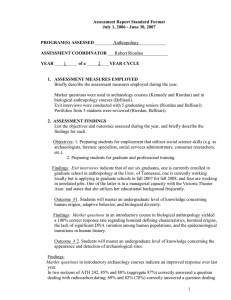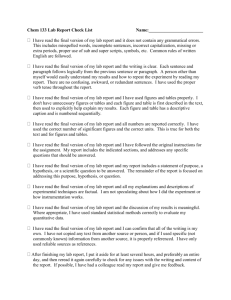Anthropology (B.A.)
advertisement

Assessment Report Standard Format July 1, 2007 - June 30, 2008 PROGRAM(S) ASSESSED _____Anthropology_____ ASSESSMENT COORDINATOR _Robert Riordan________ YEAR ____2_____ of a ____2______YEAR CYCLE 1. ASSESSMENT MEASURES EMPLOYED Briefly describe the assessment measures employed during the year. Marker questions were used in Archaeology courses (by Simonelli and Riordan) and in Biological Anthropology courses (Coate) Exit interviews were conducted with nine graduating seniors (Riordan) Portfolios from six students were reviewed by faculty 2. ASSESSMENT FINDINGS List the objectives and outcomes assessed during the year, and briefly describe the findings for each. Objectives: 1. Preparing students for employment that utilizes social science skills (e.g. as archaeologists, forensic specialists, social services administrators, consumer researchers, etc.). 2. Preparing students for graduate and professional training. Findings: Exit interviews reveal that four of the nine graduating students went directly into the workforce, one of them as an archaeologist with a Cultural Resource Management firm. The other three were not directly using their anthropology degrees, however one who graduated in August 2007 has since started graduate school this fall (2008) in Liberal Studies at Wake Forest University. One student, who graduated in November 2007 has started an MA degree in Urban Planning at the Melbourne School of Design, Australia. Another is pursuing an MA in International and Comparative Politics at WSU. Three other students are pursuing graduate degrees in anthropology at The Ohio State University, Kent State University, and Southern Illinois University-Carbondale. Outcome #1. Students will master an undergraduate level of knowledge concerning human origins, adaptive behavior, and biological diversity. Findings: Marker questions in two sections of the introductory course in biological anthropology (ATH 241) . 1 A question on human origins was correctly answered by 69% and 94% of students; a question on biological diversity was correctly answered by 61% and 83%; and a question on adaptive behavior was correctly answered by 88% and 97%. Outcome # 2. Students will master an undergraduate level of knowledge concerning the appearance and detection of archaeological sites. Findings: Marker questions in introductory archaeology courses indicate a slightly improved response over last year. In two sections of ATH 242, 46% and 77.4% (61.7% aggregate) correctly answered a question dealing with radiocarbon dating; a question dealing with damage to cultural heritage, used in three sections, was correctly answered by 84%, 96% and 84% (aggregate 88%); a second question dealing with the discovery of a major Western US site with important heritage links was administered in three sections and correctly answered by 77%, 96%, and 87% (aggregate 87%). Two essay questions used in the Archaeological Field Methods course (ATH 368) concerned the application of systematic survey techniques to the process of site discovery and were correctly answered in A or B-graded responses by 85.7% and 90.5% of students. An essay question used in the summer Field School in Archaeology (ATH 369) concerned the discovery of features within an excavation context and was answered in A or B-graded responses by 100% of the students. (A or B-graded responses on essay questions is the threshold used to evaluate mastery of content.) Outcome # 4. Students will be able to write coherent and substantive research papers and reports. The review conducted of Portfolios revealed that the work submitted by six students was both literate and appropriately substantive with respect to addressing assigned term paper topics. Scoring of the papers was conducted using a 10-point scale; on grammatical ability the students averaged 9.285; on the force and appropriateness of the arguments employed they averaged 8.74; and in the area of providing suitable documentation they averaged 9.65. 3. PROGRAM IMPROVEMENTS List planned or actual changes (if any) to curriculum, teaching methods, facilities, or services that are in response to the assessment findings. Two of the marker questions in the Introduction to Biological Anthropology course had relatively low correct responses (69% and 61%); this course was being taught by an adjunct for whom that offering was also his first solo teaching experience. The better response percentage in the second offering probably reflects more about the development of the teacher than it does about the students. 2 As in some previous years, the students in all sections of the introductory archaeology course did not all meet the self-imposed 80% success criterion in evaluating the use of radiocarbon dates, but one section was very close to 80% while another was abysmally low (46%!). The higher result was achieved by the instructor in the quarter following the 46% result, so the monitoring of marker question results would seem to have been effective in assisting the instructor to deliver that content more effectively. The ability of more advanced students in an upper division course seems to reflect their expected internalization of concepts when they have advanced beyond the introductory level. The faculty has made an effort to strengthen the ability of student majors to document their term papers and other essays, especially in terms of being able to provide a basis for their factual claims and also the adequacy of their bibliographic references. This was the area scored the highest in this year’s review, which suggests we have had a desired effect. 4. ASSESSMENT PLAN COMPLIANCE Explain deviations from the plan (if any). None. 5. NEW ASSESSMENT DEVELOPMENTS Describe developments (if any) regarding assessment measures, communication, faculty or staff involvement, benchmarking, or other assessment variables. None. 3


